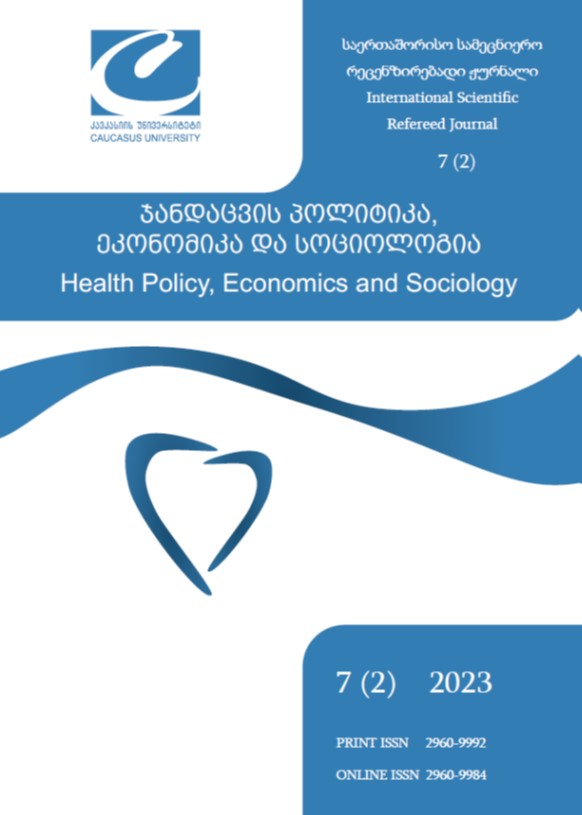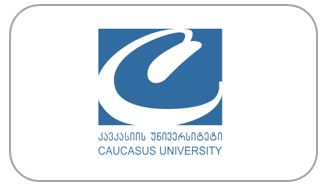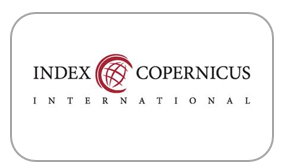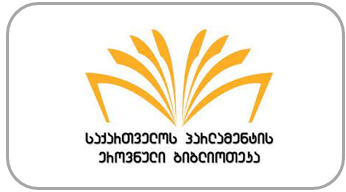საპენსიო ასაკის პირების ფინანსური ხელმისაწვდომობა გადაუდებელ ონკო-ჰემატოლოგიურ მომსახურეობაზე DRG მოდელის დანერგვის შემდეგ
DOI:
https://doi.org/10.52340/healthecosoc.2023.07.02.06საკვანძო სიტყვები:
პენსიონერები, ონკო-ჰემატოლოგიური მომსახურება, სამედიცინო სერვისებზე ხელმისაწვდომობა, დიაგნოზთან შეჭიდული ჯგუფებით დაფინანსებაანოტაცია
შესავალი: ნებისმიერი სახელმწიფოს ჯანდაცვის სისტემის უმნიშვნელოვანესი ამოცანაა მოსახლეობისთვის სამედიცინო მომსახურებაზე ფინანსური ხელმისაწვდომობის გაზრდა. 2022 წელს საქართველოში ამოქმედდა დიაგნოზთან შეჭიდული ჯგუფებით (DRG) დაფინანსების მოდელი გეგმიური და გადაუდებელი სტაციონარული მომსახურეობებისთვის, რომლის მთავარი ამოცანა ჯანდაცვის სამედიცინო სერვისებზე ხელმისაწვდომობისა და მომსახურების ხარისხის გაუმჯობესებაა. DRG მოდელის დანერგვის მიუხედავად, ონკო-ჰემატოლოგიურ პაციენტებს, მათ შორის საპენსიო ასაკის პირებს, უხდებათ გარკვეული საფასურის გადახდა ისეთი სერვისებში, რომლებსაც აქამდე სრულიად უფასოდ იღებდნენ. ნაშრომის მიზანია DRG მეთოდის დანერგვის შემდეგ გადაუდებელ ონკო-ჰემატოლოგიურ მომსახურებაზე საპენსიო ასაკის პირების ფინანსური ხელმისაწვდომობის შეფასება. მეთოდოლოგია: გამოყენებული იქნა რაოდენობრივი და თვისებრივი კვლევის მეთოდები. კვლევის შედეგები: კვლევამ აჩვენა, რომ საპენსიო ასაკის პაციენტების უმრავლესობას (78%) სტაციონარის დატოვების შემდეგ მოუხდა 235 ლარის გადახდა. ამასთან, გასათვალისწინებელია, რომ პაციენტების უმრავლესობა (64%) არ არის ფინასურად დამოუკიდებელი. შესაბამისად, რესპონდენტების უმრავლესობას (79%) შეექმნა ფინანსური სირთულეები გადაუდებელ ონკო-ჰემატოლოგიურ მომსახურებაში თანხის გადახდის გამო. რესპონდენტების უმრავლესობის (80%) აზრით DRG მოდელის დანერგვის შემდგომ მათ მიერ მიღებული ონკო-ჰემატოლოგიური სტაციონარული მომსახურების ფინანსური ხელმისაწვდომობა შემცირდა. დასკვნა: დიგნოზთან შეჭიდული ჯგუფების მოდელის დანერგვის შემდეგ ონკო-ჰემატოლოგიურ სერვისებზე დაწესებული თანაგადახდის ზემო ზღვარი საპენსიო ასაკის პირებისათვის საკმაოდ დიდ თანხას წარმოადგენს, რაც ამცირებს ფინანსურ ხელმისაწვდომობას. მიზანშეწონილია აღნიშნულ სერვისებზე დაწესებული თანაგადახდების გადახედვა.
წყაროები
ვერულავა, თ. (2023). ჯანდაცვის პოლიტიკა. კავკასიის უნივერსიტეტი.
ვერულავა, თ., ჯორბენაძე რ. (2020). ჯანდაცვაზე ხელმისაწვდომობა, როგორც ფუნდამენტური უფლება თუ პრივილეგია? ეკონომიკა და ბიზნესი, 12 (4).
ჯორბენაძე ა., ვერულავა, თ. (2021). დიაგნოზთან შეჭიდული ჯგუფებით (DRG) საავადმყოფოს დაფინანსების მეთოდი და 1995 წლის ჯანდაცვის რეფორმები. ეკონომისტი, XVII (4): 31-41
ჯანმრთელობის ეროვნული სააგენტო (2022). DRG სისტემის დანერგვა საქართველოში.https://nha.moh.gov.ge/ge/news/mosalodnelicvlilebebiDRGsisstemisdanergvastandakavshirebit. (13.06.2023).
ჯანმრთელობის ეროვნული სააგენტო (2022). დიაგნოზთან შეჭიდული ჯგუფების (DRG) მიხედვით დაფინანსების მექანიზმი. https://nha.moh.gov.ge/storage/files/shares/DRG/MOH%206%2022%2000000165%20danartiN1%20(1).pdf. (13.06.2023).
Busato, A., & von Below, G. (2010). The implementation of DRG-based hospital reimbursement in Switzerland: A population-based perspective. Health research policy and systems, 8(1), 1-6.
Busse, R., Schreyögg, J., Smith, P.C. (2006). Hospital case payment systems in Europe. Health Care Management Science, 9(3):211–13.
Cylus, J., & Irwin, R. (2010). The challenges of hospital payment systems. Euro Observer, 12(3), 1-3.
Fetter, R. B., Shin, Y., Freeman, J. L., Averill, R. F., & Thompson, J. D. (1980). Case mix definition by diagnosis-related groups. Medical care, 18(2), i-53.
Furstenberg T, Zich K, Nolting H, Laschat M, Klein S, Ha ̈ ussler B. G-DRG impact evaluation. Final report of the first research cycle (2004-2006). IGES Institut, Institut fu ̈r das Entgeldsystem in Krankenhaus. 2010.
Gulliford, M. C., Dregan, A., Moore, M. V., Ashworth, M., Van Staa, T., McCann, G., ... & McDermott, L. (2014). Continued high rates of antibiotic prescribing to adults with respiratory tract infection: survey of 568 UK general practices. BMJ open, 4(10), e006245.
Hervis, R. M. (1993). Impact of DRGs on the medical profession. Clinical Laboratory Science: Journal of the American Society for Medical Technology, 6(3), 183-185.
Langenbrunner, J., Cashin, C., & O'Dougherty, S. (Eds.). (2009). Designing and implementing health care provider payment systems: how-to manuals. World Bank Publications.
Lavis, J., Davies, H., Oxman, A., Denis, J. L., Golden-Biddle, K., & Ferlie, E. (2005). Towards systematic reviews that inform health care management and policy-making. Journal of health services research & policy, 10(1_suppl), 35-48.
Mathauer, I., & Wittenbecher, F. (2013). Hospital payment systems based on diagnosis-related groups: experiences in low-and middle-income countries. Bulletin of the World Health Organization, 91, 746-756A.
Or, Z. (2014). Implementation of DRG Payment in France: Issues and recent developments. Health policy, 117(2), 146-150.
Schreyögg, J., Stargardt, T., Tiemann, O., Busse, R. (2006). Methods to determine reimbursement rates for diagnosis-related groups (DRG): a comparison of nine European countries. Health Care Management Science, 9(3):215–23.
Scheller-Kreinsen, D., Geissler, A., & Busse, R. (2009). The ABC of DRGs in Europe Euro Observer. The Health Policy Bulletin of the European Observatory on Health Systems and Policies, Winter, 11(4).
Theurl, E., & Winner, H. (2007). The impact of hospital financing on the length of stay: evidence from Austria. Health policy, 82(3), 375-389.
Verulava, T. (2021). Access to Healthcare as a Fundamental Right or Privilege? Siriraj Med J, 73(10), 721-726.
Vogl, M. (2012). Assessing DRG cost accounting with respect to resource allocation and tariff calculation: the case of Germany. Health economics review, 2(1), 1-12.
ჩამოტვირთვები
გამოქვეყნებული
როგორ უნდა ციტირება
გამოცემა
სექცია
ლიცენზია

ეს ნამუშევარი ლიცენზირებულია Creative Commons Attribution-ShareAlike 4.0 საერთაშორისო ლიცენზიით .













